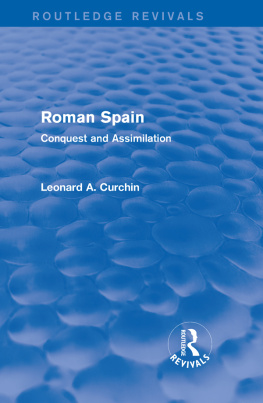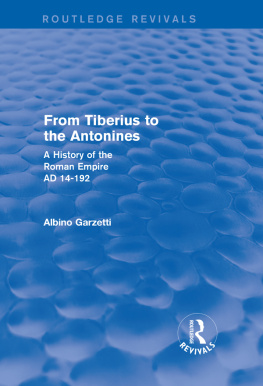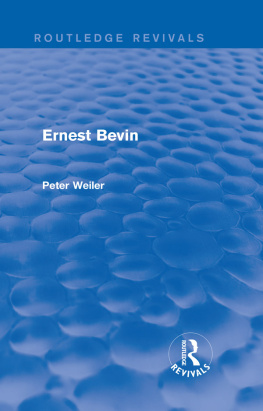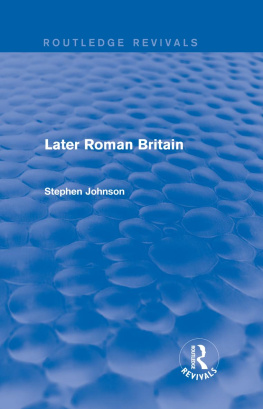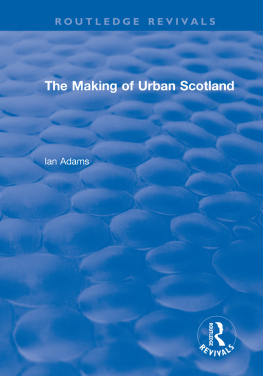Routledge Revivals
Roman Spain
The rugged, parched landscape and fierce inhabitants of the Iberian Peninsula resisted Romes best generals for two centuries. Roman Spain tells the story of this conquest, making use of the latest archaeological evidence to explore the social, religious, political and economic implications of the transition from a tribal community accustomed to grisly human sacrifices to a civilised, Latin-speaking provincial society.
From the fabled kingdom of Tartesos to the triumph of Christianity, Professor Curchin traces the evolution of Hispano-Roman cults, the integration of Spain into the Roman economy, cultural resistance to Romanisation, and surveys the chief cities of the Roman administration as well as conditions in the countryside. Special emphasis is placed on social relationships: soldier and civilian, the emperor and the provincials, patrons and clients, the upper and lower classes, women and the family.
First published 1991
by Routledge
This edition first published in 2014 by Routledge
2 Park Square, Milton Park, Abingdon, Oxon OX14 4RN
and by Routledge
711 Third Avenue, New York, NY 10017
Routledge is an imprint of the Taylor & Francis Group, an informa business
1991 Leonard A. Curchin
The right of Leonard A. Curchin to be identified as author of this work has been asserted by him in accordance with sections 77 and 78 of the Copyright, Designs and Patents Act 1988.
All rights reserved. No part of this book may be reprinted or reproduced or utilised in any form or by any electronic, mechanical, or other means, now known or hereafter invented, including photocopying and recording, or in any information storage or retrieval system, without permission in writing from the publishers.
Publishers Note
The publisher has gone to great lengths to ensure the quality of this reprint but points out that some imperfections in the original copies may be apparent.
Disclaimer
The publisher has made every effort to trace copyright holders and welcomes correspondence from those they have been unable to contact.
ISBN: 978-0-415-74031-9 (hbk)
ISBN: 978-1-315-81567-1 (ebk)
Erratum:
On p. 42 it is wrongly stated that we do not know the governors of Spain in the 80s BC. In fact, the Tabula Contrebiensis (AE 1979, 377) records C. Valerius Flaccus as governor of Citerior in 87. It thus seems likely that he proceeded from Spain to his governorship of Transalpine Gaul sometime between 87 and 85, triumphing over both provinces in 81.
Additional materials are available on the companion website at
[http://www.routledge.com/books/series/Routledge_Revivals]
First published 1991
by Routledge
11 New Fetter Lane, London EC4P 4EE
Simultaneously published in the USA and Canada
a division of Routledge, Chapman and Hall, Inc.
29 West 35th Street, New York, NY 10001
Leonard A. Curchin 1991
Typeset in 10/12pt. Garamond by
Falcon Typographic Art Ltd., Edinburgh & London
Printed in Great Britain by
T.J. Press (Padstow) Ltd, Padstow, Cornwall.
All rights reserved. No part of this book may be reprinted or reproduced or utilized in any form or by any electronic, mechanical, or other means, now known or hereafter invented, including photocopying and recording, or in any information storage or retrieval system, without permission in writing from the publishers.
British Library Cataloguing in Publication Data
Curchin, Leonard A. (Leonard Andrew)
Roman Spain: conquest and assimilation.
1. Spain. BC 218 AD 415
I. Title
936.603
Library of Congress Cataloguing in Publication Data
Curchin, Leonard A.
Roman Spain: conquest and assimilation/Leonard A. Curchin.
p. cm.
Contents: Includes bibliographical references and index.
1. Spain History Roman period, 218 B.C. 415 A.D.
2. Romans Spain. I. Title
DP94.C87 1991
936.603dc20 9021723
ISBN 0-415-06451-1
CONTENTS
The author and publishers would like to thank the following for permission to reproduce the illustrations in Roman Spain: , Museo de Navarra, Pamplona.
| AE | LAnne Epigraphique, Paris, 1888. |
| ANRW | Aufstieg und Niedergang der rmischen Welt, Berlin, 1972. |
| CIL | Corpus Inscriptionum Latinarum, Berlin, 1863. |
| HAE | A. Beltrn (ed.), Hispania Antiqua Epigraphica, Madrid, 1950. |
| ILER | J. Vives (ed.), Inscripciones latinas de la Espana romaa, Barcelona, 19712. |
| ILS | H. Dessau (ed.), Inscriptiones Latinae Selectae, Berlin, 18821916. |
| JRS | Journal of Roman Studies, London, 1911. |
| PIR2 | Prosopographia Imperii Romani, 2nd edn, Berlin, 1933. |
| RIT | G. Alfldy (ed.), Die rmischen Inschriften von Tarraco, Berlin, 1975. |
The title of this book requires a word of explanation. By Roman Spain is meant, not the territory of modern Spain in Roman times, but the land which the Romans called Spain (Hispania), encompassing present-day Spain and Portugal. I beg the indulgence of my Portuguese colleagues and assure them that, when including in Spain sites and monuments actually located in Portugal, I am referring to Hispania, not Espaa.
There are two ways to write an historical survey of a given region: a strictly chronological sequence, fitting social, economic and cultural details into their respective periods; and a typological approach, treating society, economy, religion and so on diachronically in separate chapters. For Roman Spain neither approach is wholly practicable, because of the nature of our sources. The literary evidence provides fairly full coverage (apart from occasional lacunas owing to accidents of transmission) of the political and military history of the Republican period, but very little on the Empire. On the other hand, the evidence (mostly epigraphic and archaeological) for economic, cultural and social history dates chiefly to the Early Empire. Fortunately, the completion of the Roman conquest of Spain coincides chronologically with the dividing line between these two major historical periods. Hence there is some historical justification, and not merely the desperation of being at the mercy of our sources, for dividing this study into two distinct phases, the conquest of Spain under the Republic, and its assimilation under the Empire.
Parts of the manuscript were kindly read by Drs Jonathan Edmondson, Robert Knapp, Patrick Le Roux, Ramsay MacMullen and Lucinda Neuru, all of whom I thank for their warm encouragement and for taking time from their overloaded schedules to review my drafts. Dr Jennifer Price provided valuable assistance on problems of glass production. None of these scholars is responsible for any errors of fact or opinion which have eluded detection. Finally I must thank my editor, Richard Stoneman, who first proposed this project to me and so patiently awaited its realisation.
Although Spain was an integral part of the Roman Empire, a traveller arriving from Rome or a distant province would be astounded by its many peculiarities. The length of the voyage itself at least a week from Rome to Cdiz, and almost a month from Alexandria would emphasise in the travellers mind the remoteness of Spain, whose coastlines and estuaries are oriented more toward the Atlantic than the Mediterranean. Beyond Gibraltar the placid, azure bays of the Mediterranean gradually yield to the grey-green swells of the outer ocean. Ships rigged with Spanish esparto ropes and laden with Spanish amphoras plied both seas, delivering olive oil and fish sauce to distant ports in provinces like Britain and Judaea.

